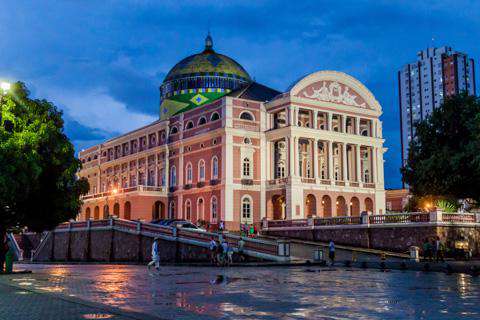Is Manaus expensive to visit?
In Manaus, budget travelers spend $60 (R$328) per day on average, mid-range travelers spend $64 (R$350) per day, and luxury travelers spend around $72 (R$391) per day. These costs are calculated from the reported expenses of previous travelers to Manaus.
Manaus is a smaller destination that attracts travelers with diverse styles, spending habits, and budgetary preferences. You'll find a wide array of accommodation options, such as luxury hotels, mid-range places, or budget-friendly hostels.
Manaus can be very expensive if you want it to be, but there are ways to cut down on your costs, like looking for discounts and coupons.
Within South America, Manaus is a moderately priced destination compared to other places. The overall cost of travel here is fair for the region and comparable to Cusco or El Calafate.
For more details, and to find out if it's within your travel budget, see Is Manaus Expensive?
How much money do I need for a trip to Manaus?
The average Manaus trip cost is broken down by category here for independent travelers. All of these Manaus travel prices are calculated from the budgets of real travelers. Also, you can see more details at How much does a trip to Manaus cost?
Realistic Expectations for Your Travel Budget
It's important to be realistic about your budget for Manaus. Many assume they can visit on a shoestring, but most travelers find that to be very challenging. Think about what matters to you when traveling. Is it staying in a resort, visiting all the attractions, or dining out at nice restaurants? These factors will determine how much you spend on your trip.
What Defines a Budget Traveler?
While you might think you're a budget traveler, without giving up many of your usual comforts, you'll likely need to spend more than the $60 per day that backpackers often spend.
Backpackers often work within this tight budget by staying in hostel dorms, eating fast food or street food, using public transit, and mainly visiting free attractions.
Fortunately, Manaus has plenty of hostels such as Local Hostel Manaus, Hostel Manaus, and Angatu Hostel Service. At hostels like these, you can find cheap accommodation in a dorm as well as a social atmosphere, but with very little amenities.
So, are you average?
If you're a couple or a family on a fun getaway, you might want to choose a mid-range hotel, enjoy meals at well-liked restaurants, and visit the key museums and attractions that come with entry fees. Many who visit Manaus will seek to enjoy the major attractions, museums, and iconic landmarks. Most activities are not free, after all. Therefore, it's realistic to plan on a daily budget of about $64 per person, per day.
There's a wide selection of hotels and vacation rentals in Manaus. If you're traveling with others, sharing a hotel room with a partner, friend, or kids will help split costs and save money. When traveling as a family, look for hotels and restaurants that welcome children. Mercure Hotel Manaus is a great choice for kids, and Express Vieiralves is another wonderful option. For more family and couple-friendly places to stay, check out our Manaus hotel costs guide.
Want to Escape the Daily Grind in Style?
If your ideal trip includes every luxury and top-tier service, be ready to budget around $72 per day. A stay at nicer hotels, meals at prestigious restaurants, fancy excursions, and getting around the destination with taxis or private drivers will cost you more. Also, higher-end tours are common with luxury travelers, such as The Manaus Private City Tour with 4h Duration - offered by Viator.
Accommodation Budget in Manaus
Hotel rates in Manaus vary a lot, especially between budget and luxury options. Peak season () brings higher prices, with rates rising from an off-season averages of $ to $. Expect prices to range from $ for budget hotels to $ for luxury. Hostels, particularly dorms, are cheaper. To save money, travel off-season or book early.
Calculated from travelers like you
The average price paid in Manaus for two people for a typical double-occupancy hotel room is $82 (R$435). For one person sharing a room, the average price paid for a hotel room is $41 (R$218) per night. These costs are from the reported spending of actual travelers.
Looking for a hotel in Manaus? Prices vary by location, date, season, and the level of luxury. See below for options.
The most affordable highest rated hotels in Manaus include:
- Hotel Villa Amazonia starting at $165
- TRYP by Wyndham Manaus starting at $53
- Hotel Adrianopolis All Suites starting at $48
- Manaus Hoteis Millennium starting at $43
- Solo Nunes starting at $27
If you avoid and go during the low or shoulder season, you'll find better hotel deals and fewer tourists.
Transportation Budget in Manaus
Calculated from travelers like you
-
On average, past travelers have spent $7.63 (R$41) per person, per day, on local transportation in Manaus. The cost of a taxi ride or rideshare service (Uber/Lyft) in Manaus is significantly more than public transportation.
-
Transportation1
Taxis, local buses, subway, etc.
$7.63
R$41
The nearest airport, Eduardo Gomes International Airport, is located about 14 kilometers north of downtown Manaus. American Airlines operates one daily flight to and from Miami, Air Portugal flies to and from Europe, and many lines operate flights domestically to and from other Brazilian cities. From the airport, visitors can take taxis or buses to the city center.
Manaus is also a major destination for boats along the Amazon River, connecting it to cities like Belem, Porto Velho, Tabatinga on the border with Colombia, and Iquitos in Peru.
Some of the standard hotel transfers and transport options include:
- 24-hour transfer from airport to hotel in Manaus for $17 details
- Transfer service from Iberostar (Port) to Manaus Airport for $23 details
- Shared Round-Trip Transfer: Eduardo Gomes International Airport for $64 details
How much does it cost to go to Manaus? Naturally, it depends on the dates. We recommend Kayak because they can find the best deals across all airlines.
The price of renting a car in Manaus will depends on dates, the type of car, the location, and your age. We recommend Kayak because they can find the best deals across all car rental companies.
Food Budget in Manaus
Tasting the local cuisine is a key reason for travel, so be sure to sample the unique dishes offered in the area.
Calculated from travelers like you
-
While restaurant and meal prices in Manaus can vary significantly, the average cost of food in Manaus is $21 (R$110) per day, per person, based on the spending habits of previous travelers.
-
Food2
Meals for one day
$21
R$110
When dining out, the average daily cost for food in Manaus is around $20 (R$110) per person, with previous travelers spending from $16 to $28. Generally, breakfast and lunch cost less than dinner, but this will depend on the type of restaurant and what you order.
Typical meal prices in Manaus are as follows:
- Breakfast: $2 to $6
- Lunch: $3 to $8
- Dinner: $6 to $14
- Coffee: $2
- Fast Food or Street Food: $3
Cuisine of Brazil varies greatly by region, usually a mix of indigenous, European, and African influences. Northern Brazil's cuisine, including that of the state of Amazonas where Manaus is located, is heavily influenced by indigenous cooking. As a result, local cuisine of Manaus is rich and varied. Tapioquinha, for example, is a glutinous pancake made from manioc starch, usually buttered and filled with tucumã palm fruit and farmer's cheese. Other delicacies include an Amazon local soup called tacacá, fish dishes like tambaqui and pirarucu, pamonha made from green corn and coconut milk boiled in corn husks, a glutinous cake made from manioc known as bolo de macaxeira, sugar cane juice, and exotic fruits like cupuaçú and açaí. There are plenty of street stalls and restaurants serving these items and more within the city.
Many hotels include breakfast in their price, while some add it on as an extra charge. The price and quality can vary depending on the hotel. Knowing ahead of time can help you decide if you need to spend even more money. Maybe it's worth your money for the delicious buffet at the hotel. Or, perhaps you should just go to a nearby bakery or cafe that's much cheaper.
Keep a water bottle handy instead of buying drinks everywhere. It's also a great way to reduce waste.
If you're planning to take a tour, make sure you know which meals are included beforehand. You might be on the hook to pay for some of the food yourself which can add to your budget.
Taking a food tour or cooking class is a great way to experience the culture in Manaus. After all, cuisine is one of the reasons why so many people visit. A few of the best culinary activities here include:
- Food Tour for $60 details
- Folklore Amazonian Dinner Show for $42 details
 Manaus, Brazil
Manaus, Brazil

 Budget Your Trip is all about finding out how much everything costs so that you can travel cheaper and longer. Created by avid travelers Laurie and Bryan, our goal is to help you plan your next trip on the right budget. With average daily travel costs that are calculated from the budgets of real travelers, plus an analysis of hotel and tour prices, you can find out how much money you need to plan your next adventure. We also have plenty of travel advice, accommodation reviews, and activity suggestions.
Budget Your Trip is all about finding out how much everything costs so that you can travel cheaper and longer. Created by avid travelers Laurie and Bryan, our goal is to help you plan your next trip on the right budget. With average daily travel costs that are calculated from the budgets of real travelers, plus an analysis of hotel and tour prices, you can find out how much money you need to plan your next adventure. We also have plenty of travel advice, accommodation reviews, and activity suggestions.